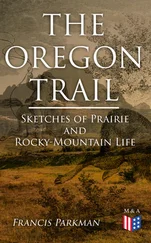Francis Parkman - A Half-Century of Conflict - Volume II
Здесь есть возможность читать онлайн «Francis Parkman - A Half-Century of Conflict - Volume II» — ознакомительный отрывок электронной книги совершенно бесплатно, а после прочтения отрывка купить полную версию. В некоторых случаях можно слушать аудио, скачать через торрент в формате fb2 и присутствует краткое содержание. Жанр: foreign_prose, История, foreign_edu, foreign_antique, на английском языке. Описание произведения, (предисловие) а так же отзывы посетителей доступны на портале библиотеки ЛибКат.
- Название:A Half-Century of Conflict - Volume II
- Автор:
- Жанр:
- Год:неизвестен
- ISBN:нет данных
- Рейтинг книги:4 / 5. Голосов: 1
-
Избранное:Добавить в избранное
- Отзывы:
-
Ваша оценка:
- 80
- 1
- 2
- 3
- 4
- 5
A Half-Century of Conflict - Volume II: краткое содержание, описание и аннотация
Предлагаем к чтению аннотацию, описание, краткое содержание или предисловие (зависит от того, что написал сам автор книги «A Half-Century of Conflict - Volume II»). Если вы не нашли необходимую информацию о книге — напишите в комментариях, мы постараемся отыскать её.
A Half-Century of Conflict - Volume II — читать онлайн ознакомительный отрывок
Ниже представлен текст книги, разбитый по страницам. Система сохранения места последней прочитанной страницы, позволяет с удобством читать онлайн бесплатно книгу «A Half-Century of Conflict - Volume II», без необходимости каждый раз заново искать на чём Вы остановились. Поставьте закладку, и сможете в любой момент перейти на страницу, на которой закончили чтение.
Интервал:
Закладка:
The bold exploit of the brothers Mallet attracted great attention at New Orleans, and Bienville resolved to renew it, find if possible a nearer and better way to Santa Fé, determine the nature and extent of these mysterious western regions, and satisfy a lingering doubt whether they were not contiguous to China and Tartary. [Footnote: Instructions données par Jean-Baptiste de Bienville à Fabry de la Bruyère, 1 Juin, 1741 . Bienville was behind his time in geographical knowledge. As early as 1724 Bénard de la Harpe knew that in ascending the Missouri or the Arkansas one was moving towards the "Western Sea,"—that is, the Pacific,—and might, perhaps, find some river flowing into it. See Routes qu'on peut tenir pour se rendre à la Mer de l'Ouest, in Journal historique , 387.] A naval officer, Fabry de la Bruyère, was sent on this errand, with the brothers Mallet and a few soldiers and Canadians. He ascended the Canadian Fork of the Arkansas, named by him the St. André, became entangled in the shallows and quicksands of that difficult river, fell into disputes with his men, and after protracted efforts, returned unsuccessful. [Footnote: Extrait des Lettres du Sieur Fabry. ]
While French enterprise was unveiling the remote Southwest, two indomitable Canadians were pushing still more noteworthy explorations into more northern regions of the continent.
CHAPTER XVI
THE WESTERN SEA.—SCHEMES FOR REACHING IT.—JOURNEY OF CHARLEVOIX.—THE SIOUX MISSION.—VARENNES DE LA VÉRENDRYE.—HIS ENTERPRISE.—HIS DISASTERS.—VISITS THE MANDANS.—HIS SONS.—THEIR SEARCH FOR THE WESTERN SEA.—THEIR ADVENTURES.—THE SNAKE INDIANS.—A GREAT WAR-PARTY.—THE ROCKY MOUNTAINS.—A PANIC.—RETURN OF THE BROTHERS.—THEIR WRONGS AND THEIR FATE.
In the disastrous last years of Louis XIV, the court gave little thought to the New World; but under the regency of the Duke of Orléans interest in American affairs revived. Plans for reaching the Mer de l'Ouest, or Pacific Ocean, were laid before the Regent in 1716. It was urged that the best hope was in sending an expedition across the continent, seeing that every attempt to find a westward passage by Hudson Bay had failed. As starting-points and bases of supply for the expedition, it was proposed to establish three posts, one on the north shore of Lake Superior, at the mouth of the river Kaministiguia, another at Lac des Cristineaux, now called Lake of the Woods, and the third at Lake Winnipeg,—the last being what in American phrase is called the "jumping-off place," or the point where the expedition was to leave behind the last trace of civilization. These posts were to cost the Crown nothing; since by a device common in such cases, those who built and maintained them were to be paid by a monopoly of the fur-trade in the adjacent countries. It was admitted, however, that the subsequent exploration must be at the charge of the government, and would require fifty good men, at 300 francs a year each, besides equipment and supplies. All things considered, it was reckoned that an overland way to the Pacific might be found for about 50,000 francs, or 10,000 dollars. [Footnote: Mémoire fait et arresté par le Conseil de Marine, 3 Fév. 1717; Mémoire du Roy, 26 Juin, 1717. ]
The Regent approved the scheme so far as to order the preliminary step to be taken by establishing the three posts, and in this same year, Lieutenant La Noue, of the colony troops, began the work by building a stockade at the mouth of the Kaministiguia. Little more was done in furtherance of the exploration till three years later, when the celebrated Jesuit, Charlevoix, was ordered by the Duke of Orléans to repair to America and gain all possible information concerning the Western Sea and the way to it. [Footnote: Charlevoix au Comte de Morville, 1 Avril , 1723.]
In the next year he went to the Upper Lakes, and questioned missionaries, officers, voyageurs, and Indians. The results were not satisfactory. The missionaries and the officers had nothing to tell; the voyagers and Indians knew no more than they, but invented confused and contradictory falsehoods to hide their ignorance. Charlevoix made note of everything, and reported to the Comte de Toulouse that the Pacific probably formed the western boundary of the country of the Sioux, and that some Indians told him that they had been to its shores and found white men there different from the French.
Believing that these stories were not without foundation, Charlevoix reported two plans as likely to lead to the coveted discovery. One was to ascend the Missouri, "the source of which is certainly not far from the sea, as all the Indians I have met have unanimously assured me;" and the other was to establish a mission among the Sioux, from whom after thoroughly learning their language, the missionaries could, as he thinks, gain all the desired information. [Footnote: The valuable journal of Charlevoix's western travels, written in the form of letters, was published in connection with his Histoire de la Nouvelle France . After his visit to the Lakes, he went to New Orleans, intending to return in the spring and continue his inquiries for the Western Sea; but being unable to do this, he went back to France at the end of 1722. The official report of his mission is contained in a letter to the Comte de Toulouse, 20 Jan. 1723.]
The Regent approved the plan of the mission; but the hostile disposition of the Sioux and the Outagamies prevented its execution for several years. In 1727 the scheme was revived, and the colonial minister at Versailles ordered the Governor of Canada to send two missionaries to the Sioux. But the mission required money, and the King would not give it. Hence the usual expedient was adopted. A company was formed, and invested with a monopoly of the Sioux fur-trade, on condition of building a fort, mission-house, and chapel, and keeping an armed force to guard them. It was specially provided that none but pious and virtuous persons were to be allowed to join the Company, "in order," says the document, "to attract the benediction of God upon them and their business." [Footnote: Traité de la Compagnie des Sioux, 6 Juin, 1727. ] The prospects of the Company were thought good, and the Governor himself was one of the shareholders. While the mission was given the most conspicuous place in the enterprise, its objects were rather secular than spiritual,—to attach the Sioux to the French interest by the double ties of religion and trade, and utilize their supposed knowledge to reach the Pacific. [Footnote: On this scheme, Vaudreuil et Bégon au Ministre, 4 Oct. 1723; Longueuil et Bégon au Ministre, 31 Oct. 1725; Beauharnois et Dupuy au Ministre, 25 Sept. 1727. ]
Father Guignas was made the head of the mission, and Boucher de la Perrière the military chief. The party left Montreal in June, and journeying to the Mississippi by way of Michillimackinac, Green Bay, Fox River, and the Wisconsin, went up the great river to Lake Pepin, where the adventurous Nicolas Perrot had built two trading-posts more than forty years before. Even if his timeworn tenements were still standing, La Perrière had no thought of occupying them. On the north, or rather west, side of the lake his men found a point of land that seemed fit for their purpose, disembarked, cut down trees, and made a square stockade enclosing the necessary buildings. It was near the end of October before they were all well housed. A large band of Sioux presently appeared, and set up their teepees hard by. When the birthday of the Governor came, the party celebrated it with a display of fireworks and vociferous shouts of Vive le Roi, Vive Charles de Beauharnois, while the Indians yelped in fright and amazement at the pyrotechnics, or stood pressing their hands upon their mouths in silent amazement. The French called their fort Fort Beauharnois, and invited the aid of Saint Michael the Archangel by naming the mission in his honor. All went well till April, when the water rose with the spring floods and filled fort, chapel, and houses to the depth of nearly three feet, ejecting the whole party, and forcing them to encamp on higher ground till the deluge subsided. [Footnote: Guignas à Beauharnois, 28 Mai, 1728. ]
Читать дальшеИнтервал:
Закладка:
Похожие книги на «A Half-Century of Conflict - Volume II»
Представляем Вашему вниманию похожие книги на «A Half-Century of Conflict - Volume II» списком для выбора. Мы отобрали схожую по названию и смыслу литературу в надежде предоставить читателям больше вариантов отыскать новые, интересные, ещё непрочитанные произведения.
Обсуждение, отзывы о книге «A Half-Century of Conflict - Volume II» и просто собственные мнения читателей. Оставьте ваши комментарии, напишите, что Вы думаете о произведении, его смысле или главных героях. Укажите что конкретно понравилось, а что нет, и почему Вы так считаете.












